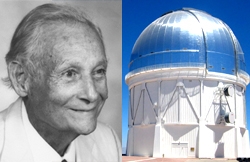Beyond the Stars... Legacy of the First Puerto Rican Astronomer, Dr. Victor M. Blanco
Submitted by Giovanna Guerrero-Medina on
The study of the planets, the stars, and the universe, in which we live, is the passion of many scientists.. Since the times of the British astronomer Edmund Halley and the British physicist Isaac Newton, the study field of Astronomy has been essential to understand what distinguishes celestial objects (position, distribution, movement, composition and energy). To achieve these objectives, astronomers make use of highly specialized instruments such as telescopes to identify the surface of the planets, measure stellar distances, and discover new stars and other stellar phenomenons.
The use of the telescope was not only an essential tool in the life of Dr. Victor M. Blanco (our first Puerto Rican astronomer), but it was also his first creation during his high school years. Born in the city of Guayama on March 10th, 1918, this Puerto Rican icon grew with the dream of becoming an astronomer. Working since his youth in his parentsí farm, he used his dreams of the skies as inspiration, even to the point of naming each of the pigs he took care of with astronomic names such as Ceres, Vesta y Ganimedes. Even though his familyís economic situation did not allow Dr. Blanco to study Astronomy, this did not deter him from taking each step in his life and projecting his decisions into what would one day become his destiny.
In 1937 Dr. Blanco began undergraduate studies at the University of Puerto Rico, in pre-Medicine. This not being his true passion, he also enrolled in his first Astronomy class. It is here that he meets a professor that encourages him to go to University of Chicago as the ideal place to specialize in the field of Astronomy. After saving money working as a furniture maker for two years, Dr. Blanco goes to United States to
follow the advice of this professor who became his first mentor. We could say that it was precisely in this moment that a star was born.
In 1941, with the help of the Director of the Department of Astronomy of the University of Chicago, Dr.Otto Struve, Dr. Blanco obtains a job as an assistant in the McDonald Observatory in Texas, where he broadens his intellectual knowledge by working for the first time with a professional-quality telescope. Years later, he completes his doctoral degree at the University of California in Berkeley, and in 1949 he returns to the island of Puerto Rico to serve as a professor of Physics and elemental Astronomy. One year later, under the advice of Dr. Struve, Dr. Blanco returns to the U.S. and joins the Case Institute of
Technology in Cleveland, Ohio, where he offers courses in Astronomy and Math.
Among his numerous contributions to the astronomy world, Dr. Blanco is highly recognized for his participation in and help to the Astronomic Observatory in Chile, his services as the director of the Cerro Tololo
Inter-American Observatory (CTIO) and the creation of the first telescope of 4m, which was commissioned in 1974 and completed in 1976. Currently, this telescope carries his name: Victor M. Blanco Telescope.
With approximate 180 scientific publications, in which Dr. Blanco presents findings about astronomical phenomena such as type M stars, stars of carbon, the clouds of Magallanes, comets, Supernova 1978A, the red giants and the stars RR Lyra, etc., Dr. Blanco has established a solid foundation for astronomic students and scientists around the world. The achievements of Dr. Blanco, who is currently 92 years old and
resides in U.S, Florida, go beyond the stars that we can all see. Patrik Osmer, a disciple and ex-director of Cerro Tololo, remembers Dr. Blanco as the man who established and maintained strong bonds between the Chilean and North American astronomical community. His professional ethics, his constant service to others and his dedication to the growth and development of Astronomy as a Natural Science, won the
respect and admiration of many.
The community of CienciaPR, as well as the family of Puerto Rican astronomers, is honored in recognizing Dr. Blanco as the pioneer of Astronomy in our archipelago and we are grateful for his legacy and lessons of discipline, perseverance, respect and dedication.
We acknowledge Dr. Jose L. Alonso (UPR Cayey) who contributed to the creation of this cover story and is a current member of CienciaPR.org








